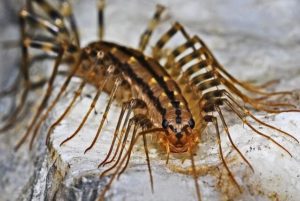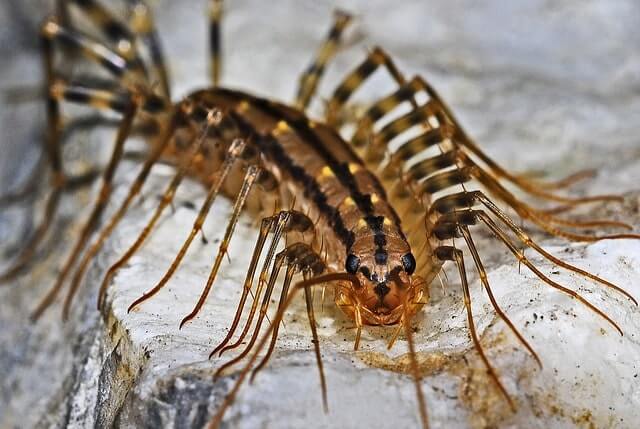When I was younger, on Sunday dinner at grandma’s house I would find millipedes in her basement – the kind that curl up in a ball. I wasn’t afraid of them then, but sometimes things that didn’t scare you as a kid scare you as an adult. Millipedes aren’t as creepy to me as centipedes. Centipedes and millipedes are more than just nuisance pests.
The term centipede literally means 100 feet, while millipede means – you guessed it – 1000 feet. These insects have segmented body parts containing only one pair of legs per segment. Both centipedes and millipedes have a varying number of legs: centipedes anywhere from 30 to more than 350 legs, and millipedes anywhere from 100 to about 750 legs.
Learn the different types of centipedes and millipedes in Minnesota and how we treat for them.
Table of Contents
Centipedes
Centipedes can range in size from a few millimeters to a foot long in some countries. Their colors range from earthy tones like brown, grey, and dark red.
Centipedes can live in nearly any environment, from humid climates like the Amazon to the frozen tundra of the Arctic circle, which make them more than just your seasonal nuisance pest. The foot long centipedes found in the Amazon eat lizards, frogs, birds, mice, and bats.
Males produce little sacs of sperm, called a spermatophore, and either leave them for females to find and engulf or they perform a mating dance to persuade the females to engulf their sperm sac.
Females lay their 15 to 60 eggs in the soil and cover them with dirt and leaves. The eggs take anywhere from 1 to 3 months to hatch. Some species have more maternal mothers, while others don’t, leaving their young until they hatch.
Centipedes are nocturnal, meaning they come out at night. All centipedes are predators, but it isn’t exactly known what they eat because they, like animals and humans, chew their food.
While these pests are creepy looking with their many legs, they pose more than just a nuisance to us: centipedes are harmful to humans. Centipedes can bite humans and can result in swelling, fever, chills, and weakness, though it is rarely fatal. Their bite is usually less severe in children, unless they have other allergies like to stinging insects. The largest centipedes’ bites can even result in anaphylactic shock, whereas the smallest centipedes bites cannot pierce human skin. This makes centipedes more than just a nuisance pest.
Did you know many centipedes technically don’t have eyes? They see through several ocelli, which is a simple optical lens. These several simple optical lenses form a compound eye, which means these independent lens units form a type of eye without retina, cones, cornea, etc.
Types of Centipedes
The brown centipede or stone centipede runs for cover once discovered. Its diet consists of spiders, slugs, worms, and flies. This type of centipede has 2 front legs that have a fang-like resemblance that helps this pest over-power its prey.
This centipede hatches with 7 pairs of legs and molts until they have 15 pairs of legs. These pests can live up to 5 or 6 years. While it is common in European countries, it isn’t exclusive to Europe. With travel so regular, these pests have become nuisances in many parts of the world.
The earth centipede is similar to the brown centipede or stone centipede. It is most common in eastern European countries and Asian countries, but has been found elsewhere.
 The house centipede is commonly found in Minnesotan homes. Its color is yellowish gray and has 15 pairs of very long legs. The house centipede strictly eats other insects and arthropods like spiders, bed bugs, termites, cockroaches, silverfish, and other arthropods. Though they eat other pests we don’t like, house centipedes are a common nuisance pest to humans.
The house centipede is commonly found in Minnesotan homes. Its color is yellowish gray and has 15 pairs of very long legs. The house centipede strictly eats other insects and arthropods like spiders, bed bugs, termites, cockroaches, silverfish, and other arthropods. Though they eat other pests we don’t like, house centipedes are a common nuisance pest to humans.
This centipede ranges in body size from 1 inch to 1.5 inches, but with its long legs and antennae, they can appear to be 3 to 4 inches long.
Millipedes
Millipedes, though they have more legs, are slower than centipedes. These pests are less dangerous than centipedes, though they can become quite a nuisance to greenhouses to little seedlings as they typically consume decaying leaf and plant material, like worms.
Millipedes range in size from 2 millimeters to 14 inches, and can have anywhere between 11 to hundreds of body segments containing 1 pair of legs each. Their bodies can be flat or cylindrical.
Males use appendages called gonopods, or modified male legs, that transfers sperm packets from the male to the female. But the location of these gonopods differs per variety of millipede, and the copulation varies depending as well.
Females lay anywhere between 30 and 300 eggs at a time, fertilizing them with the stored sperm as she lays them. They hatch with 3 pairs of legs followed by 4 body segments and molt several times, each time adding more and more legs. Depending on the species, millipedes live between 1 and 10 years!
Contrary to centipedes, millipedes don’t bite, but they do have defensive secretions. These secretions are mostly harmless to humans, though in tropical climates they can cause skin issues, ranking millipedes in the top 2 nuisance pests of this post.
Did you know millipedes breathe through 2 respiratory areas called spiracles at the base of their legs? Aren’t you glad your nose is on your face? Their heart also runs the entire length of their body!
Types of Millipedes
The spotted snake millipede is found in Europe and North America. This variety is long and thin, a whitish or cream color with reddish spots traveling the length of its body that double as ozadenes, or secretion holes for a built-in defense mechanism.
This pest feeds on outdoor plants and can be a pest to crops.
 Common millipedes are thin, little, brown, worm-like millipedes that you may find in your basement, like I found in my grandma’s basement when I was younger. These millipedes are harmless to humans.
Common millipedes are thin, little, brown, worm-like millipedes that you may find in your basement, like I found in my grandma’s basement when I was younger. These millipedes are harmless to humans.
How We Treat for These Nuisance Pests
Centipedes are more likely to inhabit your basements or crawlspaces. For centipedes we use a crawling insect treatment, which works very well because they have so many legs and their bodies are so low to the ground, they come right in contact with that product. If the centipede comes into contact with the product while wet it will die very quickly, versus if it comes into contact with it once it has dried it will die within a couple of hours. Sayonara, nuisance pests!
Millipedes are more likely to inhabit the soil and mulch around your house, so an exterior foundational spray will take care of those nuisance pests. If you have any inside, we can treat similarly to centipedes with an interior crawling insect treatment.
If you have millipedes in mulch beds, gutters, or other areas with decomposing leaves or plant matter, you may need to provide more maintenance to these areas, along with treatment. This article by Pest Control Technology online magazine gives a thorough look at these creatures, treatments, and maintenance.
Both services come with a 2 month warranty, if purchased independent from an annual service like the Peak Seasons Plan.
Centipedes and millipedes are common crawling insects. For more tips and tricks regarding crawling insects, check out our category within our blog.
Conclusion
There are hundreds of thousands of varieties of centipedes and millipedes worldwide. And while most are harmless to humans, they are considered “creepy crawlies” to most, resulting in extermination of these nuisance pests. You learned about types of centipedes and millipedes and how we treat for each. If you have any of these pests in any season and would like to see them treated proactively and preventatively, check out our in-depth article “How to Know if the Peak Seasons Plan is for You.” If you’re looking for a one-time service, give us a call at 651-342-9489 or fill out our Quick Estimate Form to start the conversation. We look forward to helping you!
For more service options, visit our Services Page.
Have you ever gotten centipedes and millipedes confused before? What is one fact you learned that you thought was interesting? Let us know!
If you found this information helpful, sign up for our email list. Where you can unsubscribe at any time, but while you’re with us you can customize your content!

